Number of entries received for the 2007 InnermoonLit Award for Best Short-Short Story to date: 59
Picking up from where we left off, here are a few of the dialogue pitfalls I referred to earlier:
*Chock fulla clichés: You know them when you see them. They’re constantly trying to worm their way onto your pages. Be ever vigilant against the cliché. Show it no mercy. Strike it dead with your red pen or backspace key. Yes, people do use a lot of clichés in their real life conversations. But you are creating art, not just recording life, and you can do better. Beware of taking it too far in the opposite direction, though, or you might end up with...
*Terminally cute dialogue: It’s good when your characters display flashes of brilliant wit. But when every single line uttered by every single character is an impossibly clever quip, well, as Brian says, the reader can hear the keyboard clacking in the background. She's popped out of the illusion of being inside a believable story. Comedians’ acts are funny nonstop (or at least they should be), but they spend hours crafting, revising, and perfecting them. Nobody is hilarious on the spot, every time he speaks.
*Arguing as a substitute for real drama: You want your story to have conflict and drama, so you make your characters argue. All well and good, but is it a juicy argument, one that advances the plot and reveals something about your characters? Or is it like that Monty Python sketch where the customer pays to have an argument but instead only gets Yes-it-is/No-it-isn’t contradiction? Your story needs conflict, but it needs to be substantial and it needs to go deeper than petty, back-and-forth squabbling.
*The Barbara Walters interview: In an effort to dump a whole bunch of information on your reader, you have one character pose a series of questions to another. Problem is, both characters know the answers full well, and if they were actual people, would have no reason whatsoever to ask each other such questions. Find a better way to reveal information to your reader, and avoid long Q&A sessions.
*Naked dialogue: No tags, no gestures, just line after line of characters talking. Your reader loses track of who is saying which line. The image of what’s actually going on in the scene goes black and the reader is popped out of the story and reminded that she is sitting in a room alone looking at words on a page. Not the effect you want. The he-said/she-said tags may seem repetitive to you, but believe me, the scene will read faster with them than without.
Oh and I think this has been said a million times, but it bears repeating: there is nothing wrong with repeating “said,” so avoid the temptation to pull out your thesaurus and stick in a bunch of "said" synonyms like “declared,” “intoned,” “stated,” “uttered,” “announced,” etc. The “said”s will disappear into the page, but the five dollar replacement words will jar the flow of your writing and stick out awkwardly.
OK, I think that covers most of the glaring dialogue gaffes we see. As with all writing "rules," they are in no way absolute, so take them with a grain of salt and use them as you see fit.
Friday, June 29, 2007
Subscribe to:
Post Comments (Atom)

No comments:
Post a Comment